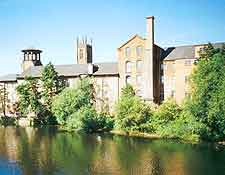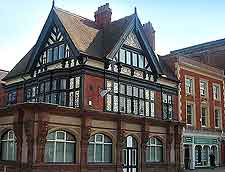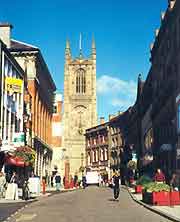Derby History Facts and Timeline
(Derby, Derbyshire, England)

Derby's early history dates back to its time as a military settlement. The town began life as a Roman fort, around 50 AD. The fort was built to the west of the River Derwent. Some 30 years later, another fort, known as Derwentio, was built, this time on the east bank of the river.
The Romans stayed for three centuries and when they eventually left, the forts gradually fell into decline. A century later, a group of Saxons arrived and established the village of Noteworthy near the site of the old forts, which they called Little Chester.
Danish to Saxon Derby
In 873 AD, the Danes arrived in force, capturing the town and fortifying it with a ditch and earth bank. The town's name was changed to Derby, derived from the Danish word 'deor', meaning deer settlement.
By the 10th century, the Saxons were once again back in control, recapturing Derby and bringing it within the English fold. It was still very much a military place, although as time went on, other tradesmen came to live and work here. By the end of the 11th century, Derby was a fair-sized town.
Medieval Derby
At the beginning of the 13th century, Derby was given a charter that granted the townsfolk the right to elect two bailiffs. A merchant's guild was also established to regulate trade in the town. These included weaving and leather working. A century later, Derby had grown considerably, becoming quite a wealthy place. A thriving religious community had also grown up by that time, including St. James Priory, a small monastery founded in 1140.

Early Modern Times
Despite outbreaks of the plague, Derby continued to prosper, with the setting up of brewing, clockmaking and cloth industries in the town. In 1637, Derby was given a new charter and its own mayor. The town even acquired its own piped water system, which its wealthier inhabitants were able to enjoy.
It's at this point in history that it became linked with Crown Derby china. To commemorate George III's visit in 1773, permission was given for a picture of a crown to appear on china goods. During Victoria's reign, it was to be renamed Royal Crown Derby.

From the 19th Century to the Present
The 19th century was a time of great development for public facilities. These included a swimming pool, library, public park, museum and even electric lighting. Many new houses were built beyond the town's existing boundaries. However, it is Derby's links with the locomotive and car building industries that are perhaps best remembered today. The railway arrived in Derby in 1840. Railway workshops grew up, employing many local workers. Then, in 1908, Rolls Royce opened a factory in the town to manufacture cars and aircraft engines.
After World War Two, Derby grew at an even faster pace, with its boundaries being extended yet further to include Littleover, Mickleover, Allestree and Darley Abbey. In 1977, Derby became a city, and today, is home to almost 250,000 people.
 Derby's early history dates back to its time as a military settlement. The town began life as a Roman fort, around 50 AD. The fort was built to the west of the River Derwent. Some 30 years later, another fort, known as Derwentio, was built, this time on the east bank of the river.
Derby's early history dates back to its time as a military settlement. The town began life as a Roman fort, around 50 AD. The fort was built to the west of the River Derwent. Some 30 years later, another fort, known as Derwentio, was built, this time on the east bank of the river.
